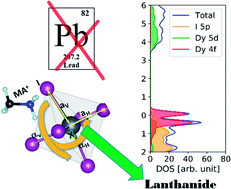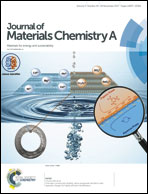Electronic structure of organic–inorganic lanthanide iodide perovskite solar cell materials†
Abstract
The emergence of highly efficient lead halide perovskite solar cell materials makes the exploration and engineering of new lead free compounds very interesting both from a fundamental perspective as well as for potential use as new materials in solar cell devices. Herein we present the electronic structure of several lanthanide (La) based materials in the metalorganic halide perovskite family not explored before. Our estimated bandgaps for the lanthanide (Eu, Dy, Tm, Yb) perovskite compounds are in the range of 2.0–3.2 eV showing the possibility for implementation as photo-absorbers in tandem solar cell configurations or charge separating materials. We have estimated the typical effective masses of the electrons and holes for MALaI3 (La= Eu, Dy, Tm, Yb) to be in the range of 0.3–0.5 and 0.97–4.0 units of the free electron mass, respectively. We have shown that the localized f-electrons within our DFT+U approach, make the dominant electronic contribution to the states at the top of the valence band and thus have a strong impact on the photo-physical properties of the lanthanide perovskites. Therefore, the main valence to conduction band electronic transition for MAEuI3 is based on inner shell f-electron localized states within a periodic framework of perovskite crystal by which the optical absorption onset would be rather inert with respect to quantum confinement effects. The very similar crystal structure and lattice constant of the lanthanide perovskites to the widely studied CH3NH3PbI3 perovskite, are prominent advantages for implementation of these compounds in tandem or charge selective contacts in PV applications together with lead iodide perovskite devices.



 Please wait while we load your content...
Please wait while we load your content...